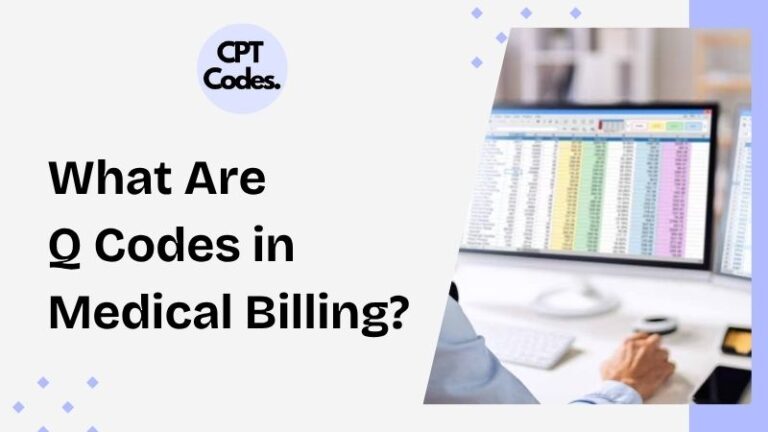One type of code that often gets overlooked but plays a key role is the Q Code in medical billing. These codes fall under the HCPCS Level II system and are essential for billing temporary services, drugs, biologicals, and durable medical equipment. In this article, we’ll take a closer look at what these codes are, how they are used, and why they matter in healthcare billing.
What Is a Q Code in Medical Billing?
Q Codes are part of the HCPCS Level II, which is used to identify non-physician services and products not included in the CPT codes. Specifically, these Codes are temporary codes assigned by the CMS. These codes usually represent services, supplies, and drugs that do not yet have a permanent code.
Each code begins with the letter “Q” followed by four digits, such as Q5101 or Q0138.
These codes are often used for:
- New drugs and biologicals
- Experimental or temporary procedures
- Durable medical equipment (DME)
- Substitutes for branded medications (biosimilars)
Why Are Q Codes Important in medical billing?
It play an essential role in ensuring proper reimbursement for healthcare providers. Since medical technologies and drugs are constantly evolving, CMS uses them to assign temporary identifiers for products and services that don’t yet qualify for a permanent code. Here’s why these codes are important:
- Facilitate Reimbursement: It ensure that providers can still bill for newer drugs or services while permanent codes are pending.
- Track Usage: CMS and other payers use these codes to monitor usage, costs, and outcomes associated with new healthcare services.
- Support Innovation: Without It, healthcare providers might not be able to offer or get reimbursed for newer treatments.
Examples of Common Q Codes
Understanding specific examples helps illustrate how these codes are used in real-world billing scenarios.
Here are a few well-known codes:
- Q5101 – Injection, filgrastim (Neupogen), biosimilar, 1 microgram
- Q0138 – Injection, Zofran (ondansetron hydrochloride), 1 mg
- Q4116 – Alloderm, per square centimeter (used in skin grafts)
- Q9981 – Imipenem-cilastatin, 1.25 grams
- Q4186 – Excellagen, for wound care, 0.1 cc
These codes are typically used in outpatient settings like hospitals, clinics, and physician offices where newer or unique services are provided.
How Are Q Codes Assigned?
They are not randomly assigned. Manufacturers, providers, or other stakeholders may request a code through CMS by submitting clinical data and product details. CMS reviews the information and may assign a temporary code if:
- The product or service is FDA approved
- There is sufficient clinical data
- The product is widely used and needs tracking for payment purposes
It can eventually become permanent HCPCS Level II codes, CPT codes, or be phased out if no longer relevant.
Billing Requirements for Q Codes
Accurate billing with these Codes requires attention to detail and thorough documentation. Here are the general requirements:
- Correct Code: Use the precise code that matches the product or service provided
- Dosage or Unit Quantity: Make sure the billed units match the code’s definition (e.g., per mg, per cc)
- Product Information: Document the product name, lot number (if applicable), and manufacturer
- National Drug Code (NDC): Many insurers require the NDC alongside the Q Code
- Supporting Documentation: Include clinical notes, especially when using experimental or biosimilar products
Q Codes vs. Other HCPCS Level II Codes
HCPCS Level II includes a wide range of alphanumeric codes. Here’s how it differs from other types:
- J Codes: Represent drugs and biologicals typically administered by a provider (e.g., injections)
- A Codes: Cover medical supplies and equipment
- C Codes: Temporary hospital outpatient procedure codes
- G Codes: Include services not found in the CPT code set
Key Difference: Q Codes are mostly temporary and often used for new or transitional services.
When to Use Q Codes
These codes are typically used in the following situations:
- A new biosimilar drug has been introduced but lacks a permanent code
- A temporary skin substitute is used in wound care
- A trial device or injectable product is provided in a study
- A service is under Medicare’s temporary coverage policy
Always check payer-specific policies, as some private insurers may not accept Q Codes for reimbursement.
How to Look Up a Q Code
Looking up the correct code can be done through various reliable sources:
- CMS HCPCS Level II Code Book
- Medicare Administrative Contractor (MAC) websites
- Billing software tools with integrated coding libraries
- Manufacturer’s websites
- Professional billing guides and coding manuals
Always cross-check multiple sources to confirm you have the most up-to-date code.
Conclusion
The Q Code in medical billing may seem like a small part of the billing process, but it plays a big role in supporting new and emerging treatments. By providing a temporary solution for services and products that don’t yet have permanent codes, it ensures that healthcare providers can continue offering high-quality care without delay in reimbursement.
For billing professionals, understanding how to use them effectively is essential. Staying informed, maintaining accurate documentation, and communicating with payers are all key to successful claims processing. As the medical field continues to innovate, these codes will remain an important tool in bridging the gap between clinical advancement and financial sustainability.

